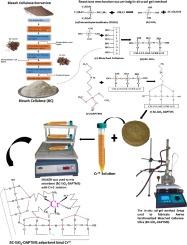胺功能化纤维素-二氧化硅复合材料用于修复受污染水体中的六价铬 (Cr IV)
IF 2.5
Q2 CHEMISTRY, MULTIDISCIPLINARY
引用次数: 0
摘要
由于重金属对公众健康的影响,从生活和工业废水中去除六价铬(Cr(VI))的吸附方法广受欢迎。本研究的目的是使用一种新型吸附剂:从香蕉纤维中提取的胺功能化纤维素-二氧化硅复合材料,对六价铬的吸附效果进行评估。我们采用原位溶胶-凝胶法制备了纤维素-二氧化硅硅烷功能化复合材料,并通过不同的表征技术对其进行了分析,如衰减全反射-傅立叶变换红外光谱(ATR-FTIR)、X 射线衍射分析(XRD)、热重分析(TGA)/差热重(DTG)、布鲁诺-艾美特-泰勒(BET)、扫描电子显微镜(SEM)和透射电子显微镜(TEM)技术。ATR-FTIR 显示了生香蕉假茎纤维(BF)中的主要有机成分和 BCSiO2 复合材料中 SiO 键的形成,在 BC-SiO2-DAPTMS 中,N-[3-(三甲氧基硅基)丙基乙二胺(DAPTMS)接枝到 BC-SiO2 表面进一步增强了该复合材料的性能。XRD 和 TGA/DTG 分析表明结晶度和热稳定性发生了变化,而 BET 分析表明 BC-SiO2-DAPTMS (2 %) 的表面积和孔隙特征发生了变化。SEM 和 TEM 成像提供了 BC-SiO2-DAPTMS 复合材料结构改变和分散性改善的直观证据。研究还考察了复合材料重量、接触时间和 pH 值对六价铬去除率的影响,结果表明,在 pH 值为 4 的微酸性条件下性能最佳(80.7%),而当接触时间增加到 65 分钟(86.66%)、复合材料重量增加到 1 克(82.62%)、初始浓度为 0.8 毫克/升(80%)时,效率则有所提高。使用伪二阶(PSO)和伪一阶(PFO)模型对动力学和等温线进行了分析,凸显了复合材料的效率。发现 Freundlich 模型更适合吸附等温线数据,而 PSO 模型更准确地描述了动力学。这些见解有助于优化 BC-SiO2-DAPTMS (2 %) 复合材料,从而在水处理应用中高效去除六价铬离子。本文章由计算机程序翻译,如有差异,请以英文原文为准。

Amine-functionalized cellulose-silica composites for the remediation of hexavalent chromium (Cr IV) in contaminated water
Adsorption method for Hexavalent chromium (Cr(VI) removal from domestic and industrial wastewater is widely desirable due to public health concern of the heavy metal. The purpose of this study was to investigate the evaluation of Cr(VI) adsorption using a novel adsorbent: amine-functionalized cellulose-silica composite derived from banana fibers. We employed the in-situ sol–gel method to create cellulose-silica silane functionalized composites, analyzing them through different characterization techniques such as Attenuated total reflectance- Fourier transform infrared spectroscopy (ATR-FTIR), X-ray Diffraction Analysis (XRD), Thermo gravimetric analysis (TGA)/differential thermogravimetric (DTG), Brunauer–Emmett–Teller (BET), Scanning Electron Microscopy (SEM), and Transmission Electron Microscopy (TEM) techniques. ATR-FTIR depicted key organic constituents in raw banana pseudo stem fibers (BF) and the formation of Si![]() O bonds in BC
O bonds in BC![]() SiO2 composite, and further enhanced by the grafting of N-[3-(trimethoxysilyl)propyl ethylenediamine (DAPTMS) onto the BC-SiO2 surface in BC-SiO2-DAPTMS. XRD and TGA/DTG analyses revealed changes in crystallinity and thermal stability, while BET analysis showcased altered surface area and pore characteristics in BC-SiO2-DAPTMS (2 %). SEM and TEM imaging provided visual evidence of structural modifications and improved dispersion in BC-SiO2-DAPTMS composites. The impact of composite weight, contact time, and pH on Cr(VI) removal rates was examined, revealing optimal performance at slightly acidic pH 4 value (80.7 %) and enhanced efficiency with increased contact time of 65 min (86.66 %), composite weight of 1 g (82.62 %), and initial concentration was for 0.8 mg/l (80 %). The kinetics and isotherms analyzed using pseudo second order (PSO) and pseudo first order (PFO) models, highlight the composite’s efficiency. The Freundlich model was found to better fit the adsorption isotherm data, while the PSO model described the kinetics more accurately. These insights contribute to optimizing the BC-SiO2-DAPTMS (2 %) composite for efficient Cr(VI) ion removal in water treatment applications.
SiO2 composite, and further enhanced by the grafting of N-[3-(trimethoxysilyl)propyl ethylenediamine (DAPTMS) onto the BC-SiO2 surface in BC-SiO2-DAPTMS. XRD and TGA/DTG analyses revealed changes in crystallinity and thermal stability, while BET analysis showcased altered surface area and pore characteristics in BC-SiO2-DAPTMS (2 %). SEM and TEM imaging provided visual evidence of structural modifications and improved dispersion in BC-SiO2-DAPTMS composites. The impact of composite weight, contact time, and pH on Cr(VI) removal rates was examined, revealing optimal performance at slightly acidic pH 4 value (80.7 %) and enhanced efficiency with increased contact time of 65 min (86.66 %), composite weight of 1 g (82.62 %), and initial concentration was for 0.8 mg/l (80 %). The kinetics and isotherms analyzed using pseudo second order (PSO) and pseudo first order (PFO) models, highlight the composite’s efficiency. The Freundlich model was found to better fit the adsorption isotherm data, while the PSO model described the kinetics more accurately. These insights contribute to optimizing the BC-SiO2-DAPTMS (2 %) composite for efficient Cr(VI) ion removal in water treatment applications.
求助全文
通过发布文献求助,成功后即可免费获取论文全文。
去求助

 求助内容:
求助内容: 应助结果提醒方式:
应助结果提醒方式:


